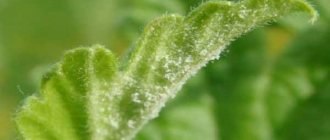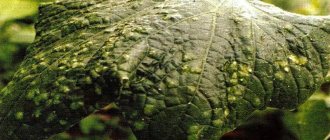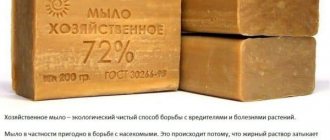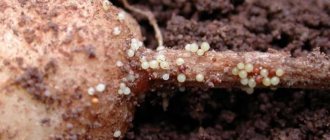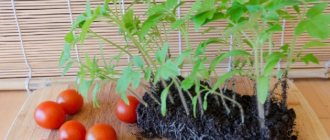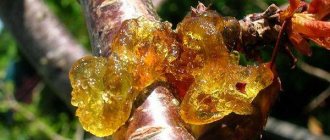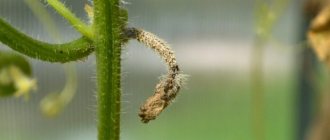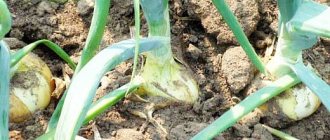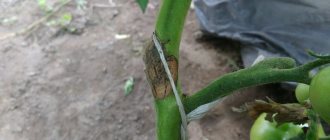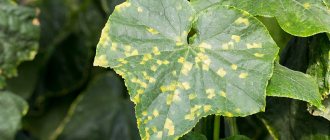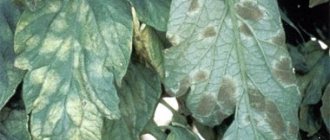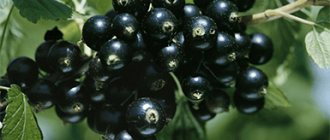1829
Not a single Russian plot can do without currant bushes. This berry supplies a person with essential vitamins, is ideal for preparing food for the winter and has a unique sweet and sour taste. A big nuisance for a gardener is the appearance of powdery mildew on currants. There are many measures to combat this disease, but complete elimination of the fungus requires a whole complex of step-by-step treatment. The use of drugs is not enough; currant bushes need competent agricultural technology and preventive measures.
Seasonal processing
Application methods
To combat the disease you will need powerful drugs.
However, a lot also depends on compliance with the rules for caring for currants and the nature of treatment with fungicides. The fungus prefers dampness, abundant watering, excess nitrogen in the soil, and shade. Eliminating these conditions and following certain recommendations when treating with fungicides significantly increases the chances of recovery. Read about varieties of brush tomatoes here.
Root treatments
Traditionally, nitrogen preparations are applied in the spring, since nitrogen stimulates plant growth and increases yield. But if infection occurs, stimulation should be abandoned.
Instead of nitrogen fertilizers, potassium and magnesium fertilizers are applied to the tree trunk circle of the bush.
All last year's leaves and branches on the ground are collected and burned. The earth is dug up to a depth of 15 cm. Find out how to grow indoor tomatoes here.
After spring watering, be sure to mulch the tree trunk circle to reduce evaporation.
Foliar
For a better harvest of Rowada, Alpine, and other varieties of currants, in the summer they are sprayed with urea or urea solutions. However, if bushes are infected with powdery mildew, foliar feeding should be completely abandoned.
Spraying
The fungus loves high humidity. Accordingly, you will have to give up spraying the bushes, no matter how sad they may look in a dry summer. Maximum sun is what kills powdery mildew.
Instead of spraying with water, it is recommended to organize drip irrigation. And to prevent the plant from shedding its existing ovaries due to weakening, it is better to carefully prune the currants in the spring.
The only permissible spraying of infected currants with water is carried out in the very early spring before the snow melts.
How to recognize powdery mildew on currants
Powdery mildew is a fungal disease that affects leaves and fruits . Black currants are usually susceptible to infection. Golden, red and white rarely get sick. Fungal spores can withstand low and high air temperatures and overwinter in soil and plant debris.
Causes of bush infection:
- proximity to infected areas;
- humid and warm air;
- weeds under bushes;
- excess nitrogen in the soil;
- heavy pruning;
- dense planting.
Black currants suffer from powdery mildew 2 times a year - after flowering and during the ripening period of the berries.
Symptoms:
- white coating on the tips of the shoots;
- brown spots on leaves and branches;
- plant growth retardation;
- deformation and drying of shoots;
- curled and pale leaves;
- whitish coating on the berries and cessation of growth;
- deterioration of fruit taste.
During the fruiting period, powdery mildew affects berries, shoots, and fruit branches . The plant stops growing, dries out, loses its protective powers, and its resistance to frost decreases.
Interesting things on the site:
Currant diseases, methods of control and prevention
Why do currant bushes dry out and what to do?
Currant leaves turn yellow in June: what to do
Processing stages
The fight against the fungus should begin in early spring. Some gardeners prefer chemical means, some use folk remedies. In practice, it is better to combine them, since chemicals, although effective, are poisonous and it is no longer possible to treat currants with them, for example, after the ovary has formed.
Processing is carried out in accordance with the recommendations, but, as a rule, consists of several stages:
- spring - includes both spraying the bush and treating the tree trunk. Depending on the duration of the drug, several procedures will be required;
- summer involves spraying with chemical compounds before the berries begin to ripen and treating with biological compounds as needed. In any case, the procedure is repeated at least 4 times;
- autumn - includes removing old branches, infected leaves and shoots and burning them. The tree trunk circle is completely cleared of leaves. If necessary, apply phosphorus-potassium fertilizers or wood ash.
Spring
The largest list of work is carried out in the spring.
- Even before the snow melts, the currant bush is irrigated with boiling water. The tops of the shoots are dipped in a container of boiling water. The procedure should take a minimum amount of time, so it is completed very quickly.
A very good way to reduce the risk of the appearance or recurrence of the disease is to replace the top fertile soil with new humus. This option brings very good results, since fungal spores overwinter in the soil.
- The tree trunk circle under the bushes can be treated with tansy solution to destroy the fungus.
- In early spring, before the buds swell, currants are sprayed with a solution of copper sulfate. At this moment, moisture-charging spring watering is carried out.
Until the leaves appear, it is unclear whether the bush is infected or not. But if whitish spots are found on young leaves, treatment should be started immediately.
- Spraying with biological or chemical preparations is carried out immediately. It is best to do it before flowering, as this reduces the risk of disease and berries. One treatment is not enough, since the fungus is very resistant to the action of fungicides, so currants are sprayed at least 3-4 times in accordance with the instructions for the drug.
As a rule, spraying occurs before flowering, during flowering and immediately after. When the berries begin to ripen, it is advisable not to treat currants with chemical fungicides, since they are poisonous. Biochemical preparations can be used until the end of summer. However, procedures involving them have to be repeated much more often. Find out if you can freeze leeks for the winter using this link.
Spraying requires either a very good powerful spray bottle or a soft brush. It is necessary that the drug gets on both sides of the sheet, so the treatment must be carried out very carefully.
Development of the disease
In our conditions, the main source of spring infections are fruiting bodies that are released from spores created on infected organs of currants and gooseberries. Infection occurs in the first warm days of spring.
In each environment there is only one bag containing 8 spores. The spores are unicellular, colorless, irregular, ovoid in shape, with dimensions of 20-25 × 12-15 microns.
Primary infections caused by spores are rare. The fungus only affects young shoots, leaves up to 10 days old, and berries. After 2 weeks, visible signs of damage appear.
The appearance of symptoms of the disease in the form of a flaky coating of mycelium and conidial chains of spores gives rise to secondary infections, which, under favorable conditions, can lead to the spread of the pathogen. Conidial spores, such as oidium, form chains; they are unicellular, colorless, ellipsoidal, 24-27 × 16-18 µm in size.
The disease develops best in summer when dry, warm weather facilitates the development, release and spread of spores. The optimal temperature for the development of the disease is 20-30 degrees C. Thickened plantings contribute to the spread of the disease.
In warm climates, the fungus overwinters as mycelium, mainly inside infected buds. Conidial spores can also be the source of primary infections.
Chemical and biochemical preparations
To treat powdery mildew, two types of synthetic drugs are used: biofungicides and chemicals.
Biochemical
The fungus is destroyed using a somewhat unusual mechanism.
For example, fungal biofungicides contain a culture of a parasitic fungus that multiplies on the sphere library and ultimately suppresses its vital activity. Bacterial preparations include bacteria that can actively destroy the fungal shell, releasing antibiotics and amino acids. This option is practically harmless to human health. You can treat bushes with it at any time, including when the berries are ripening. However, biofungicides have a fairly short duration of action, are water-soluble and are easily washed off by rain. Accordingly, the spraying procedure must be repeated often: usually once every 5–7 days. This article will tell you about growing and caring for Suvorov’s onions.
Chemical
Usually they are pesticides of various types.
They are toxic substances: spraying is carried out only in a respirator, goggles and closed clothing. Fungicides are very effective, but you should not get carried away with them, since the preparations contain heavy metals, and the latter tend to accumulate. Chemicals last much longer. On average, up to 3 treatments per season are needed to get rid of fungus. Systemic ones are preferable, as they prevent infection, and not only protect the plant from fungal spores. But, if the disease has affected only a small area or even neighboring bushes, it is preferable to use protective fungicides: such a preparation covers the shoots and leaves with a layer of active substances that prevent infection, but is not absorbed into the leaf blade or ovary.
It is important to pay attention to the composition of the drug. Thus, in spring, preference is given to dithiocarbamic acid, since it to some extent stimulates plant growth. In summer it is better to use copper-containing preparations.
Treatment should be carried out in calm, dry weather, preferably in the evening, when the sun is not so active.
Metronidazole
A better known name is Trichopolum. This is an antibacterial remedy, sold in tablet form at the pharmacy. The medicine is used to treat a variety of fungal diseases in humans, such as trichomoniasis, gingivitis, and gynecological ailments.
It turned out that the drug is also quite effective against powdery mildew and late blight.
For spraying, 3 tablets of trichopolum or metronidazole are dissolved in 500 ml of water and sprayed on the plants. This is done for the first time as soon as traces of the disease are discovered. If the first procedure is carried out before flowering, the effect will be greater.
Spraying is repeated in late May-early June, when fungal spores begin to spread. If, after a week, powdery mildew is still found on the currants, then the plant is treated with trichopolum every day until complete recovery. It is also recommended to water the plants with a metronidazole solution.
The drug does not affect the fruits in any way. You can safely eat the berries after washing them first.
Boric acid
Boric acid is usually used as a foliar fertilizer in cases where garden crops lack boron.
Treatment with a solution of the substance stimulates the growth of berries, makes the pulp more juicy and fleshy, so black currants are periodically sprayed with this preparation.
Against powdery mildew, boric acid is used together with potassium permanganate: 2 g of each substance is dissolved in a 10 liter bucket of water. Then 40 drops of iodine are added to the composition and the plants are sprayed as a protective biofungicide.
The procedure is carried out after the leaves appear. If necessary, repeat during flowering, after and during the formation of the ovary.
Bordeaux mixture
Bordeaux mixture is a mixture of slaked lime, water and copper sulfate solution. It was first used in vineyards, and today it is used as one of the most universal means for combating fungal diseases.
A big plus of the product is the duration of action. 1 spraying is enough for a month. Rain cannot wash off the drug. So there is no need to repeat spraying after every thunderstorm.
- As a preventive measure, both fruit trees and berry fields are treated with a 1% solution of Bordeaux mixture in early spring, before the buds begin to swell.
- If the currant is infected, but partially, and the bush is generally healthy, then 3 procedures are carried out: before the leaves bloom, at the beginning of the growing season and after flowering.
- If powdery mildew has affected all the bushes, then the number of treatments increases to 6 times. The last spraying is carried out no later than 2–3 weeks before picking the berries. The maximum number of procedures cannot be exceeded: copper accumulates not in the plant, but in the soil. Its excess weakens the currant, it grows more slowly and produces a much smaller harvest.
Bordeaux mixture is a contact pesticide. To get maximum effect, the plant should be treated very carefully.
Bordeaux mixture is incompatible with organophosphate pesticides, so when using various preparations for powdery mildew and scab, you need to monitor the composition. Work should be carried out only in protective clothing, goggles and a respirator, since copper-containing preparations pose a significant threat to humans.
Copper sulfate
A simplified version of Bordeaux mixture. Depending on the purpose, 1% and 3% solutions are used. As a rule, solutions of lower concentrations are prepared for spraying shrubs.
Currants are treated with copper sulfate in the spring before the buds open. This is a standard preventive measure, since the substance effectively destroys many fungal diseases.
When a bush is completely infected, the solution is also used for treatment, just like Bordeaux mixture and boric acid. However, the solution has a shorter shelf life, so the treatment is repeated every 10–14 days until fruit formation. A total of no more than 4 procedures are allowed.
You can also use copper-soap emulsion. To do this, prepare a soap solution: 50 g of laundry soap is dissolved in 10 liters of water, and then a 1% solution of copper sulfate is added to it - 200 ml. The resulting mixture is sprayed onto currants every 7 days.
HOM
An alternative to Bordeaux mixture. This is a copper-containing drug with a very strong effect. Currants are sprayed with a 0.4% HOM solution, that is, 40 g per 10 liters of water.
HOM can be mixed with Fufanon and Decis - 1 bottle each. In this way, complex treatment against fungal diseases is performed.
Spray currants with HOM once - before flowering.
Score
Chemical fungicide based on difenoconazole from the class of triazoles. A broad-spectrum drug used against fungal diseases such as powdery mildew, blight, coccomycosis, and moniliosis. Acor inhibits sporulation, which leads to a decrease in the intensity of the infection and its complete disappearance.
Scor begins to act 2 hours after spraying. Rain, wind and temperature do not affect the effect.
The drug is diluted with water - 2 ml per bucket, and the plant is sprayed. For a bush, 2 procedures are sufficient with an interval of 10–12 days if this is a preventive treatment, and after 8 days if the currant is already sick. In extreme cases, 3 sprayings are allowed after the same period.
Fitosporin
This is a bacteriological biofungicide that inhibits mycelial growth.
The drug is used both as a prophylactic and for treatment. However, when infected, phytosporin is effective only at the first stage of the disease. Fitosporin should be activated. To do this, the contents of the package are diluted in a small amount of water and left for 5–6 hours. During this time, the solution turns into a suspension. A tablespoon of this suspension is added to 10 liters of water, and the resulting mixture is sprayed on the plants. Currants are processed once in early spring.
If the bushes still become sick, repeated treatment does not make sense. It is recommended to use a more potent product.
Fungicides
Both organic and inorganic fungicides are used to treat currants. Organic does not include heavy and dangerous metals such as mercury and copper. They are very easy to prepare - just dilute the powder with water, and can be combined with many other pesticide formulations.
Inorganic ones are more dangerous because they include metals, and the latter tend to accumulate in the soil, which is harmful to the plant. However, inorganic preparations are the most potent agents, so if the garden is heavily infested, they have to be used.
Fundazol
Broad-spectrum fungicide.
The active substance is benomyl: it disrupts nuclear division in cells and thereby prevents the proliferation of the fungus. Fundazol performs this function for 3 days, and then becomes a regular protective drug for another week. Not only leaves and shoots are treated with foundationazole, but also the soil. The drug is used in the form of a solution - 1 g of the substance per 1 liter of water. The first treatment is carried out when an infection is detected, the next one – after 10-14 days. Both 3 and 4 procedures are allowed, while maintaining the specified time period.
Topaz
Fungicide based on penconazole. Unlike many other chemicals, it combines well with other fungicides and insecticides. Available in the form of ampoules or in bottles of different capacities.
Topaz is the most popular remedy against powdery mildew. It is used very sparingly, acts for 2–3 weeks, is well tolerated by plants and does not cause poisoning.
The composition inhibits the growth of mycelium within 3 hours after spraying.
For the procedure, 2 ml of topaz is dissolved in a small amount of water, and then the composition is diluted into 10 liters. Currants are treated with this solution for prevention and at the first signs of illness.
For prevention, fertilizing is carried out during the growing season and repeated after 12–14 days. If powdery mildew does not appear within 20 days, then the fungus does not threaten currants.
When treating already infected bushes, the interval between procedures is reduced to 8 days. To spray 1 bush, 1.5 liters of working fluid is enough. 3 treatments are allowed.
You cannot spray currants with topaz during flowering.
Previkur
Systemic drug for combating true and downy mildew, based on prolamocarbofosetyl.
The drug penetrates the leaves, accumulates in them and destroys the mycelium. In addition, previkur has a stimulating effect on the growth of leaves and berries.
For the procedure, 5 ml of previcur is diluted in 1 liter of water and sprayed on the plant. You need to make sure to wet the sheet on one side and the other with the composition.
It is also effective to water the soil around the currants with a solution of the drug - 3 ml per 1 liter of water.
Repeated treatment is carried out after 10–14 days.
Plants should be sprayed in the evening or in the morning when the sun is inactive.
Vitaros
Not the most suitable preparation for processing currants. Destroys almost any type of fungus. Stays on the surface of the processed material for a long time. Initially intended for grain disinfection.
To spray currants, dissolve 2 ml of the drug - a capsule - in 10 liters of water. Vitaros has the form of a suspension, so it is first dissolved in a small amount of water, and then the composition is diluted to 10 liters.
Spray the bushes with Vitaros before flowering.
Pesticide Information
Drug : the name of the pesticide, its preparative form, the content of the active substance, the registrant, the state registration number, restrictions and the expiration date of the registration period are indicated. Numerical designations separated by fractions from (1) to (4) after the registrant indicate the hazard classes of the drugs. The numerator is the hazard class for humans, the denominator is for bees in field conditions. (P) - prohibition of use in the sanitary zone around fishery reservoirs at a distance of 500 m from the flood line at the maximum standing of flood waters, but not closer than 2 km from the existing banks . For pesticides intended for pre-sowing treatment of seeds, it is prohibited to treat seeds in the specified zone; sowing of treated seeds is permitted.
Application rate : the application rates of pesticides are indicated (by preparation): for solid formulations - in kg/ha (for seed protectants - in kg/t), for liquid formulations - in l/ha (for seed protectants - in l/t ). In other cases, application rates given in other units of measurement are indicated next to the numerical value of the pesticide application rate. The application rates for herbicides are given based on continuous tillage; with the belt application method, the application rate is reduced in proportion to the decrease in the cultivated area. (A) - permission for aerial treatments in these application regulations. (L) - permission to use the drug on private farms. Regulations for the use of the drug on private farms are presented in a separate line.
Culture : Cultures are indicated. Two crops, for example, tomato and cucumber, are indicated for both open and protected ground, unless specifically stated.
Harmful object : harmful objects against which this pesticide is recommended are indicated; for desiccants and plant growth regulators - the purpose of the drug.
Method, processing time, application features : the method, processing time, application features are posted. The expression “Consumption – 400 l/ha”, “Consumption – 12 l/t”, etc. means the flow rate of the working fluid (solution, emulsion or suspension), unless “Working fluid flow rate” is indicated.
Waiting period (frequency of treatments) : waiting times are indicated, with the number of treatments in parentheses. The waiting period is the time interval between treatment with the drug and harvesting, indicated in days. If the use of a pesticide is clearly one-time, for example, pre-sowing seed treatment, then a dash (-) or (1) may be indicated in the sixth column.
Timing of exit for manual (mechanized) work : the timing of people entering areas treated with pesticides to carry out manual (mechanized) work to care for plants is given in days.
Permanent link to the page
rupest.ru
Folk remedies
A variety of folk remedies are also used to combat powdery mildew. For the most part, they are of natural organic origin, easily decompose in the soil, and do not pose a danger to humans or animals.
The general disadvantage of such compositions is low efficiency and water solubility. Rain and even strong winds completely neutralize their effect. Accordingly, the processing has to be repeated more often.
- Baking soda - more precisely, a soap-soda solution. Mix 50 g of baking soda or soda ash, the same amount of grated laundry soap and dissolve in 10 liters of hot water. After the liquid has cooled, the bush is sprayed with it, making sure that the leaves are treated on both sides. The procedure is repeated every other week until the powdery mildew disappears.
- Kefir and whey - fermented milk products give good results, especially in the initial stages of the disease. 1 part whey or kefir is dissolved in 10 parts water and sprayed on the plants 3 times in a row. The procedure is repeated every 3 days. The products form a film on the surface of the leaf that does not allow the fungus to multiply. In rainy weather, such a film is immediately washed off, so after rain, spraying is repeated unscheduled.
- Potassium permanganate is a strong disinfectant, quite suitable for fighting fungi. For currants, ½ teaspoon of potassium permanganate is dissolved in 10 liters of water and the plants are treated three times. Repeat the procedure every 5 days.
Potassium permanganate is effective only in the initial stages of powdery mildew.
- Soap solution - Soap is included in several options for fighting fungus. For example, a soap emulsion obtained by mixing a 1% solution of copper sulfate and a soap solution (50 g of soap per bucket of water) is an extremely effective preparation. The emulsion is sprayed on currants 3 times every 7 days.
The soap-ash solution is prepared as follows: 1 kg of wood ash is poured into 10 liters of boiling water and left for 1-2 days. Add up to 50 g of soap to improve the adhesion of the composition; after 2 days, spray the currants with the solution. The procedure is repeated twice after 7–10 days.
- Horsetail - 100 g of fresh grass, pour 1 liter of water and leave for 24 hours. Then the infusion is boiled for 2 hours over low heat, cooled and filtered. The infusion is stored in the refrigerator. Before spraying, the infusion is diluted in a ratio of 1:5 and currants are treated with it. Perform 3–4 procedures every 5 days.
Biological control measures
Proponents of growing berries using an environmentally friendly method can use biological control techniques to cure the plants - water the bushes with slurry or rotted mullein. Bacteria are bred in manure to destroy the fungus.
For treatments, prepare a solution of mullein (25-50%). Fermented slurry is diluted with water in a ratio (1 to 1). 3 sprays are carried out with mullein solution:
- before currant blossoms;
- after flowering;
- in preparation for winter, before leaf fall.
Preventive measures
To reduce the risk of powdery mildew, follow these recommendations:
- The varieties most resistant to the disease are selected for planting. It is better to purchase seedlings from a trusted nursery;
- purchased seedlings must be treated with copper-containing preparations;
- When planting, you need to maintain a distance between the bushes. Closely planted plants shade each other, dry out for a long time after rain, which creates suitable conditions for the proliferation of fungus;
- treatment with insecticides also helps against powdery mildew, since insects are often its carriers;
- weeds should be destroyed, leaves and infected branches should be removed, and be sure to burn them;
- pruning and lightening the bush provides good lighting and quick drying after rain, thereby reducing the risk of fungus development.
Prevention measures
- Plantings should be made from resistant or less susceptible varieties.
- It is important to provide the bushes with appropriate growing conditions, a sunny and ventilated position. Currants should not be grown in places where there is high humidity and frequent fog (for example, in recessed areas).
- Dried bushes need to be uprooted.
- When watering, you should avoid irrigating entire bushes - it is better to apply water directly to the soil.
- Avoid spreading weeds. Plantings need to be weeded regularly to prevent weeds from causing excessive thickening, making it difficult for them to dry out in the wind.
- When planting, currants should be planted at the correct distance so that the bushes do not grow too densely (1.5 meters spacing between bushes is recommended).
- Regular thinning of bushes, removal of old shoots and overly thickened ones.
- Rational phosphorus-potassium fertilizer. It is necessary to apply nitrogen fertilizers in a limited manner, avoiding their excess.
- Digging the soil under the bushes in autumn and spring.
Currant resistance to disease increases when high doses of potassium and phosphorus fertilizers are applied.
conclusions
- Powdery mildew or berry death is one of the most severe fungal diseases of currants. Infection in the first year deprives the owner of 80% of the harvest.
- Today there are no currant varieties that are completely resistant to powdery mildew. However, among the zoned varieties you can always find the most resistant ones: they respond better to treatment and recover faster.
- The most effective drugs for controlling powdery mildew are chemical fungicides. However, these substances are toxic and require strict compliance with all rules for use.
- Less effective, but much safer, are biofungicides. Such drugs act for a shorter period of time, so currants have to be processed much more often.
- Folk remedies are also used to treat shrubs: horsetail infusions, potassium permanganate solution, soap-ash emulsions.
- An obligatory element in the fight against powdery mildew is compliance with the rules of care: pruning bushes, timely disinfection, preventive spring treatment with copper-containing preparations, etc.
This material will tell you when to plant cucumber seedlings according to the lunar calendar.
Caring for a sick plant
To completely defeat a fungal disease, you need to carry out the entire range of measures to combat the disease. Experienced gardeners give a lot of advice on how to combat the disease, and no less important are tips on how to properly care for a plant that has been attacked by this fungus:
- You should refrain from spraying. They contribute to the development of the disease;
- It is necessary to provide the shrub with maximum sunlight;
- Densely planted plants will have to be trimmed;
- It is necessary to prune all old and diseased branches;
- When the disease subsides, nitrogen fertilizers should not be used. It is better to use potassium or magnesium fertilizers.
If you follow all the above tips, you will soon be able to control this disease in your garden.
